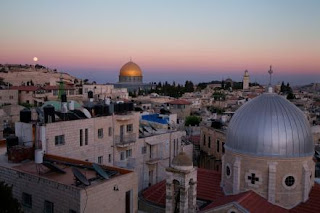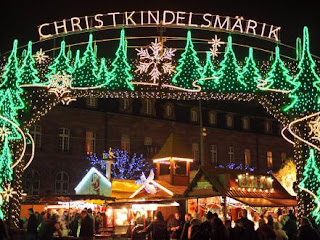10 Must-See Historic Sites in
Israel
You've just begun to explore Israel's richculture and history when you visit these famous places.
Jaffa
Jaffa , the world's oldest port city, is a
short drive from Tel Aviv. The Bible says Jonah sailed from Joppa, as it was formerly known, before he was thrown into the sea and swallowed by a whale. Stroll through the old center of town to haggle for everything from antiques to secondhand clothes, or Persian tiles to Hamsa keychains (the Hamsa symbol, which looks like an open hand, is said to ward off evil). Stop for creamy hummus in a
Mid-Eastern cafe, or snap pictures of the blue Mediterranean Sea behind the sand-colored buildings. Don't miss the Monastery of St. Peter, an 1812 mosque and the house of Simon the Tanner, where the apostle Peter may have once stayed.
Masada
King Herod's palace once stood atop
Masada, a flat-topped mesa in the Judean Desert. Today, this UNESCO World Heritage Site is a symbol of Jewish courage, commemorating almost a thousand Jewish men, women and children who made a last
stand against Roman invaders in 73 C.E. For centuries, Masada lay undisturbed, until archeologists began uncovering its ruins in 1828. Get the whole story about this historic site from the Visitors' Center before you hike or ride a cable car to the
top. Then explore the remains of colorful mosaic floors, storerooms, a heated bathhouse and much more.
Baha'i Shrine and Gardens
The city of Haifa, home of the Baha'i
Shrine and Gardens, lies in northern
Israel. With its golden dome and fabulous, flowering terraces, the shrine is sacred to the Baha'i faith. It's also a World Heritage Site and the final resting place for the prophet Baha'u'llah, known as the Bab.While you're in Haifa, visit the beautiful
Carmelite Monastery, built in the early 1880s, and Elijah's Cave, a synagogue where tradition says the Hebrew prophet once prayed. You'll need a head covering to go in; loaners are usually available at the entrance.
Sea of Galilee
Pilgrims come from all over the world to the Sea of Galilee, which is actually a freshwater lake near Israel's borders with Syria and Jordan. It's here that the Bible says Jesus preached and walked on water.
In nearby Tiberias, visit the 19th-century Church of St. Peter, built by Crusaders, and a Greek Orthodox Monastery that dates to 1862. Tiberias has become a popular resort area with hotels, restaurants and shops, and offers water sports like kayaking and water skiing.
Basilica of the Annunciation
Built in Nazareth in 1969, the Basilica ofthe Annunciation is one of the most
magnificent modern churches in the Middle East. Some Christians believe it rests on the site where the angel Gabriel told Mary she would conceive God's son. Archeologists have excavated two earlier structures
under the present-day church: a Byzantine church from the 4th or 5th century, and one from the era of the Crusades.
Church of the Holy Sepulcher
Jerusalem's Church of the Holy Sepulcher is probably the most sacred one in Christendom, but it's not the first on its site. An earlier church existed there around 330 A.D. When you visit today, you'll find a complex dating back to the 12th century that serves six faiths: Greek Orthodox, Coptic, Roman Catholic, Syrian,
Ethiopian and Armenian Orthodox. This multi-storied structure can be confusing to navigate, as it's dimly lit, crowded and maze-like, and the lines to see Christ's Tomb are often long. Allow plenty of time to visit.
Mount of Olives
In Biblical times, olive trees grew on the Mount of Olives, a hill east of Jerusalem. According to the New Testament, Jesus visited the area many times, and this holy place is also where Jews, Christians and
Muslims have buried their dead for
thousands of years. There's much to see here: the Tomb of Mary, the Mosque of the Ascension, several churches, the Tombs of the Prophets, and the garden and grotto of Gethsemane. Go early in the day, when the light is good, for breathtaking views of the surrounding countryside.
Yad Vashem
Yad Vashem is known as the World
Holocaust Remembrance Center. Here, a collection of artifacts, a research center, outdoor memorials and sculptures and an art and history museum commemorate the
lives of over six million Jews who perished in the Holocaust. Visitors must dress appropriately; shorts and short skirts are not permitted, and groups of six or more should schedule their visits in advance . The Hall of Names is pictured here.
Western Wall
The Western Wall, also called the Wailing Wall or Ha-Kotel, in Hebrew, draws believers of all faiths who come to pray and tuck notes into the cracks between its ancient stones. Two thousand years ago, the wall, built by Herod the Great, encircled the Temple Mount. Today, only a
portion remains, and it's divided into
sections for men and women. Be sure to book a tour through the Western Wall tunnels when you visit. Archeologists are still making important finds.
Dome of the Rock
The roof of Jerusalem's famous Dome of the Rock is covered in gold leaf that
shines in the sun. Built somewhere between 688 and 691 A.D., it's the oldest Islamic monument still in existence. This beautiful example of Classical and Byzantine architecture houses a rock revered by Muslims and Jews. In the Islamic faith, the
rock is believed to be the place from which the prophet Muhammad ascended. To Jewish believers, it's where the Holy of Holies stood in Herod's Temple, and where God asked Abraham to sacrifice Isaac, his
son.
The city of Haifa, home of the Baha'i
Shrine and Gardens, lies in northern
Israel. With its golden dome and fabulous, flowering terraces, the shrine is sacred to the Baha'i faith. It's also a World Heritage Site and the final resting place for the prophet Baha'u'llah, known as the Bab.While you're in Haifa, visit the beautiful
Carmelite Monastery, built in the early 1880s, and Elijah's Cave, a synagogue where tradition says the Hebrew prophet once prayed. You'll need a head covering to go in; loaners are usually available at the entrance.
Sea of Galilee
Pilgrims come from all over the world to the Sea of Galilee, which is actually a freshwater lake near Israel's borders with Syria and Jordan. It's here that the Bible says Jesus preached and walked on water.
In nearby Tiberias, visit the 19th-century Church of St. Peter, built by Crusaders, and a Greek Orthodox Monastery that dates to 1862. Tiberias has become a popular resort area with hotels, restaurants and shops, and offers water sports like kayaking and water skiing.
Basilica of the Annunciation
Built in Nazareth in 1969, the Basilica ofthe Annunciation is one of the most
magnificent modern churches in the Middle East. Some Christians believe it rests on the site where the angel Gabriel told Mary she would conceive God's son. Archeologists have excavated two earlier structures
under the present-day church: a Byzantine church from the 4th or 5th century, and one from the era of the Crusades.
Church of the Holy Sepulcher
Jerusalem's Church of the Holy Sepulcher is probably the most sacred one in Christendom, but it's not the first on its site. An earlier church existed there around 330 A.D. When you visit today, you'll find a complex dating back to the 12th century that serves six faiths: Greek Orthodox, Coptic, Roman Catholic, Syrian,
Ethiopian and Armenian Orthodox. This multi-storied structure can be confusing to navigate, as it's dimly lit, crowded and maze-like, and the lines to see Christ's Tomb are often long. Allow plenty of time to visit.
Mount of Olives
In Biblical times, olive trees grew on the Mount of Olives, a hill east of Jerusalem. According to the New Testament, Jesus visited the area many times, and this holy place is also where Jews, Christians and
Muslims have buried their dead for
thousands of years. There's much to see here: the Tomb of Mary, the Mosque of the Ascension, several churches, the Tombs of the Prophets, and the garden and grotto of Gethsemane. Go early in the day, when the light is good, for breathtaking views of the surrounding countryside.
Yad Vashem
Yad Vashem is known as the World
Holocaust Remembrance Center. Here, a collection of artifacts, a research center, outdoor memorials and sculptures and an art and history museum commemorate the
lives of over six million Jews who perished in the Holocaust. Visitors must dress appropriately; shorts and short skirts are not permitted, and groups of six or more should schedule their visits in advance . The Hall of Names is pictured here.
Western Wall
The Western Wall, also called the Wailing Wall or Ha-Kotel, in Hebrew, draws believers of all faiths who come to pray and tuck notes into the cracks between its ancient stones. Two thousand years ago, the wall, built by Herod the Great, encircled the Temple Mount. Today, only a
portion remains, and it's divided into
sections for men and women. Be sure to book a tour through the Western Wall tunnels when you visit. Archeologists are still making important finds.
Dome of the Rock
The roof of Jerusalem's famous Dome of the Rock is covered in gold leaf that
shines in the sun. Built somewhere between 688 and 691 A.D., it's the oldest Islamic monument still in existence. This beautiful example of Classical and Byzantine architecture houses a rock revered by Muslims and Jews. In the Islamic faith, the
rock is believed to be the place from which the prophet Muhammad ascended. To Jewish believers, it's where the Holy of Holies stood in Herod's Temple, and where God asked Abraham to sacrifice Isaac, his
son.





















































